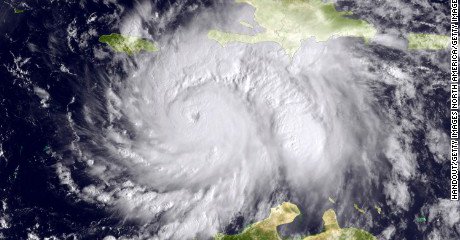
A powerful hurricane continued to march toward the Southeastern United States on Wednesday as authorities in states readying for the storm’s devastating combination of winds and rain declared emergencies, ordered evacuations and shuttered schools.
After Hurricane Matthew pummeled Haiti on Tuesday – causing at least 10 deaths there and six in the Dominican Republic and other parts of the Caribbean – it weakened slightly before continuing on to the Bahamas and barreling toward Florida, where forecasters warned it could batter the state’s eastern coast for hours.
Officials including President Barack Obama in Washington, D.C., and governors in Florida, Georgia and the Carolinas urged residents to take the storm seriously, pleas that came as Matthew was poised to be the most powerful storm to make landfall in the country in more than a decade. At least half a million people along the southern East Coast were being urged to evacuate.
“If Matthew directly impacts Florida, there will be massive destruction that we haven’t seen in years,” Florida Gov. Rick Scott, R, said during a news conference.
If Matthew is a Category 3 or stronger hurricane when it hits Florida, it will be the first major hurricane to make landfall in the country since Hurricane Wilma in 2005.
“This is a serious storm,” Obama said after he was briefed on hurricane preparations at the headquarters of the Federal Emergency Management Agency (FEMA) in Washington. He added: “You can always rebuild, you can always repair property. You cannot restore a life if it is lost.”
Obama had been scheduled to visit Florida for two events Wednesday, but he scrapped that trip because of the storm and went to FEMA for the briefing instead, according to the White House. He warned that the storm “could have a devastating effect” even in areas spared the full force of the hurricane, and he asked residents to pay attention to local leaders and follow evacuation orders.
The National Hurricane Center reported that the storm had maximum sustained winds near 120 mph on Wednesday, with higher gusts, and “some strengthening” was expected in the coming days. The center also said Wednesday that it was extending hurricane warnings along much of Florida’s eastern coast.
Scott closed state offices in more than two dozen Florida counties and said he activated 500 members of the Florida National Guard, with 6,000 more ready to be deployed as needed. Some mandatory evacuations were in place Wednesday in Florida, along with voluntary evacuations in St. Lucie, Flagler and Duval counties, which are home to more than 1.2 million people. More evacuation plans were expected, he said.
In South Carolina, Gov. Nikki Haley, R, activated the South Carolina National Guard and said the state would evacuate coastal communities and close all coastal schools. Even before mandatory evacuations went into effect in the state, roads were jammed as people tried to leave the region.
Haley ordered the evacuation of Charleston and Beaufort counties on Wednesday afternoon, and she said other areas were expected to be evacuated Thursday morning.
“For those of you that are wondering whether you should leave or not, I again will tell you that if you do not leave, you are putting a law enforcement officer or a National Guardsman’s life on the line when they have to go back and get you,” she said.
Charleston Mayor John Tecklenburg stressed the importance of residents’ leaving quickly.
“If everybody waited until the last minute and tried to get on the road at the same time, it would just be a congestive nightmare,” he said. “If you’ve got a place to go, if you’ve got friends or family in another part of the state and you can go ahead, relocate, and get out of here. The sooner the better.”
The North Carolina emergency declaration covered 66 counties in parts of eastern and central North Carolina. Gov. Pat McCrory, R, said that includes areas that have recently experienced substantial flooding and remain saturated. Two weeks earlier, McCrory declared an emergency in counties flooded by the remains of Tropical Storm Julia.
In Florida, public school districts in Broward, Palm Beach and Miami-Dade counties all said they would close Thursday and Friday, as would others farther north past the Gold Coast and up into southern Georgia. The Marine Corps said it was evacuating recruits training at its Parris Island, South Carolina, base.
Universities also announced plans to cancel classes, although some were still planning to play scheduled football games.
Airlines announced that they would waive fees for travelers changing flights because of the storm. Delta, JetBlue and American Airlines said they were letting customers change flights scheduled in the coming days through much of the U.S. Southeast as well as the Bahamas and Caribbean.
NASA’s Kennedy Space Center said it would close on Wednesday at 1 p.m. and remain closed through Friday.
A spokesman for SpaceX said that the company was “working with our partners at Kennedy Space Center and Cape Canaveral Air Force Station to safeguard facilities and personnel in the potentially affected areas.” United Launch Alliance, a joint venture of Boeing and Lockheed Martin that conducts launches from Cape Canaveral, also said it was preparing for the storm.
(c) 2016, The Washington Post · Mark Berman

